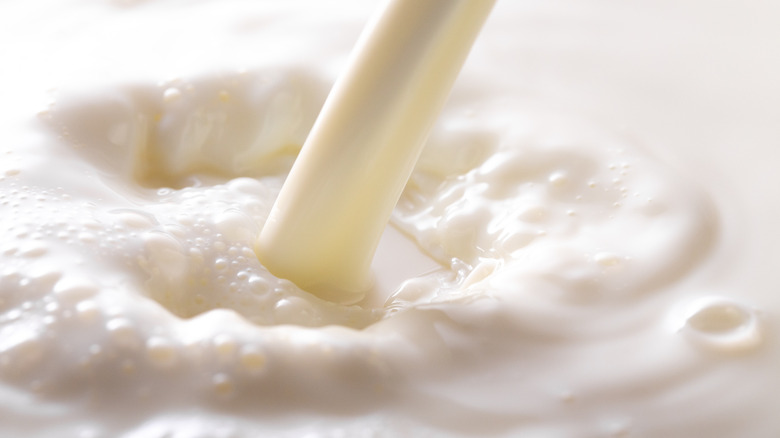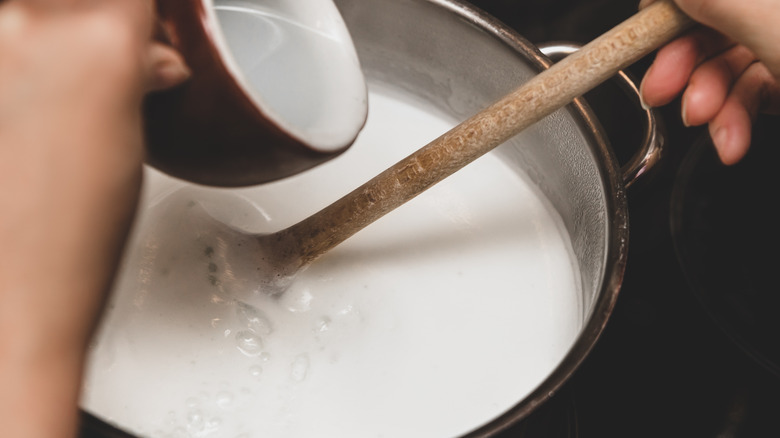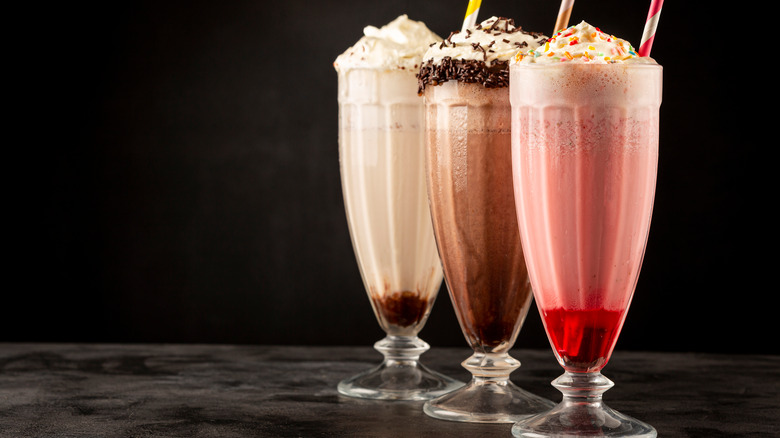Think Twice Before You Consider Cooking With Skim Milk
From adding moisture to baked goods to serving as a base for rich sauces, milk is an indispensable kitchen ingredient for many cooks, and can be a valuable part of a healthy diet. Both the USDA and the HHS recommend incorporating low-fat dairy into your diet, and if you're trying to cut down on fat or calories, you may prefer to pick up skim milk at the grocery store over varieties like whole milk. However, you shouldn't always choose skim milk over fattier dairy products. While it may be fine in your cereal, smoothies, or coffee, it can cause problems when you try to use it in cooking.
When skim milk interacts with acid or heat, its protein molecules cluster together in a process known as curdling. It turns clumpy, separated, and unappetizing. Fat can protect dairy products against curdling, which is why rich heavy cream is almost guaranteed not to curdle when you cook it, while fat-free skim milk is extra prone to this effect. Skim milk will not smoothly blend into broths, curries, and sauces in the same way that cream, whole milk, or even 2% milk could. Only cook with skim milk for recipes that require curdling, such as homemade cottage cheese or paneer cheese.
Use milks with more fat to prevent curdling
Skim milk curdles easily because manufacturers remove much of its fat content before shipping it off for sale. Fat provides a layer of protection for milk's protein molecules, which can be separated from its liquid base when exposed to heat. While this is one reason why skim milk doesn't perform well in cooking, many also consider it to be flavorless, which little to no taste or richness — perhaps not what you want in your meal.
If you've already done your grocery shopping, and you didn't get a chance to grab a carton of whole milk, don't worry. You can transform skim milk into heavy cream by mixing butter into it. This will add fat back into the milk, creating a richer alternative that can be added to savory dishes with ease. Just keep in mind that this mixture cannot be beaten into soft, fluffy peaks in the same way whipping cream can, which makes it highly inefficient for desserts such as mousse.
Keep skim milk for recipes with minimal heat
While skim milk does not interact well with soups, casseroles, sauces, and other hot foods, it works great for cold treats that do not require high temperatures. Cold milkshakes and smoothies are great options for using up skim milk. It can be especially useful in a post-workout protein smoothie or shake, since plain milk hydrates your body better than water. Skim milk can provide hydration and more protein than plain old water, making for a more satisfying drink. Since fat can also dull flavors and make cold treats like popsicles taste less refreshing, it can be worth it to use skim milk instead for a cleaner flavor and less heavy mouthfeel.
If you want to swap out whole milk in your drink recipes, but find skim milk's taste (or lack of it) off-putting, try out some vegan substitutes, such as unsweetened soy or almond milk. These milk alternatives usually have a nuttier flavor and richer mouthfeel than skim milk, which can make for a better beverage. Both of these also options have fewer calories and lower levels of saturated fat when compared to whole milk. However, unfortified almond milk tends to have lackluster levels of calcium, protein, and vitamins, so if you really want a boost of nutrition out of your drink, try to look for the fortified kind.



